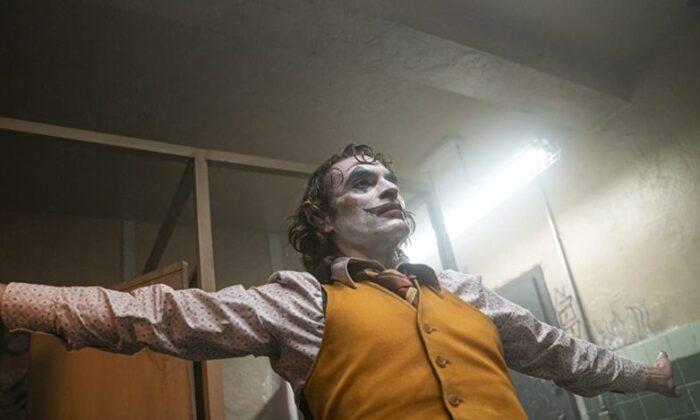“It’s a movie about one man’s descent into madness,” said the ticket taker. “Nothing else.”
Why was the ticket seller pre-reviewing this movie for me? The line seemed overly rehearsed, a cautionary note to viewers as a way to prevent what has concerned people, namely that the movie’s fictional mayhem would generate real-world copycats. This was the great worry at the time.
Still, his mini-review did give me some reassurance. The previews alone were too creepy. Life is tough enough without movies introducing more sadness, which is precisely why I like to stick with uplifting fare. Still, I marshaled my way through this one.
There is a superficial way in which the man was correct. This was just about one guy. Even after leaving, I kept telling myself that. And yet after it was over, I experienced precisely what so many others reported at the time. The movie imparts an aura that you can’t shake. You take it home with you. You sleep with it. You wake up in the morning and see that damned face again. You think through scenes. Then, you remember things. Then more starts to make sense—not moral sense but narrative sense.
It was also tremendously unpleasant viewing, the most difficult two-plus hours of movie watching I can remember. It was also brilliant and gripping in every frame. The score is perfect. And the acting didn’t seem like acting.
As for the “just one man” interpretation, that’s hard to sustain. The street scenes. The subways packed with people wearing clown masks, headed to the protest. The rich, established businessman running for mayor and the protests that engenders. The strange way in which this unsettling and violent figure becomes a folk hero on the streets. There was surely a larger point here.
Yes, I had seen the usual tug-of-war on Twitter about what it meant. It’s pro-Antifa! It’s a conservative warning against extremist politics! It’s a right-wing smear against the leftward drift of the Democrats! It’s a left-wing apologia for the rise of the workers against the elites, so of course, eggs need to be broken!
The trouble is that none of those narratives explained the various twists and turns, and the unease and ambiguity that the film created within the viewer.
It took me a full day to come up with an alternative theory. The thesis probably pertains to all renderings of the Joker in print or film but this one is particularly prescient because its sole focus is on the one character, with the most elaborate backstory yet given.
The trouble begins with personal life failures. While this man is troubled, you sometimes think that perhaps he isn’t so far gone as to be irredeemable. He might function well. He can get through this, just like everyone else deals with their own demons. Joaquin Phoenix does a great job of slipping in and out of crazy. He seems to behave fine around his mother, and his brief girlfriend. He has interactions that aren’t totally wrecked by his eccentricity.
Yet there are life circumstances that keep driving him more and more to the point that he loses love for life as it is. He gives up hope and fully embraces despair as a way of thinking and living. And then he does evil and discovers something that empowers him: His conscience doesn’t provide a corrective. On the contrary, the evil he does makes him feel empowered and valued.
To review: His life wasn’t working; he found something that worked for him finally. Then he embraced it.
What is that thing he embraced? It has a particular name in the history of ideas: Destructionism. It’s not just a penchant; it’s an ideology, an ideology that purports to give shape to history and meaning to life. That ideology says that the sole purpose of action in one’s life should be to tear down what others have created, including the liberties and lives of others.
This ideology becomes necessary because doing good seems practically impossible, because one still needs to make some difference in the world to feel that your life has some direction, and because doing evil is easy. The ideology of destructionism enables a person to rationalize that evil is at least somehow preparing the ground for some better state of society in the future.
What is that better state? It could be anything. Maybe it’s a world in which everyone owns everything equally. Maybe it is a world without happiness or a world with universal happiness. Maybe it’s a world without faith. Maybe it’s national production with no international trade. It’s a dictatorship—society conforming to One Will. It’s the absence of patriarchy, a world without fossil fuels, an economy without private property and technology, production without the division of labor. A society of perfect morality. The ascendance of one religion. A germ-free world!
Whatever it is, it’s illiberal and therefore unworkable and unachievable, so the advocate must eventually find solace not in creating but in destroying the existing order.
Destructionism becomes a psychology of wreckage imparted by an ideology that is a failure by the necessity of theory and practice. The Joker failed at life and so sets out to destroy it for others. So, too, are those consumed by an ideological vision to which the world stubbornly refuses to conform.
This is why any left/right interpretation of “Joker” is too limited.
The movie came out only a few months before virus lockdowns. Was it a premonition? Probably in some way. In those days, we were gorged by media and politics with insane visions of how society should work. It shouldn’t surprise us when these visionaries ultimately turn to anger, then dehumanization of opponents, and then plot plans for tearing down what exists just for the heck of it.
That “what is” could be world trade, energy consumption, diversity, human choice generally, the freedom of association, the chaos of enterprise, the existence of the rich, a degenerate race, the frustration of one man with his absence of effective power. Hardly anyone imagined what would become the ideological basis of destructionism: pathogenic control.
Destructionism is stage two of any unachievable vision of what society should be like against a reality that refuses to conform. Destructionism also proves to be strangely compelling to populist movements that are anxious to externalize their enemies (the infected, the unvaccinated) and smite the forces that stand in the way of their reassertion of power.
Finally, such people discover satisfaction in destruction—as an end in itself—because it makes them feel alive and gives their life meaning.
The Joker, then, isn’t just one man, not just a crazy person, but the instantiation of the insane and morbid dangers associated with persistent personal failure backed by a conviction that when there is a fundamental conflict between a vision and reality, it can only be solved by the creation of chaos and suffering. As unpleasant as it is, “Joker” is the movie we needed to see to understand and prepare for the horrors that this unchecked mentality can and did unleash on the world.
The idea of lockdowns was literally unthinkable until it was suddenly mainstreamed in late February 2020. Only a few weeks later, it became a reality. We were told that it was all to stop a virus. It completely failed on the front but it achieved something else. Lockdowns and now mandates have empowered a ruling elite to try out a new theory of how life can work. The failure of their efforts is everywhere in evidence.
Do they now stop? Or find new ways to destroy that create more chaos, more distractions, more instability, more randomness, more experiments with the unthinkable?
The Joker did create copycats.





